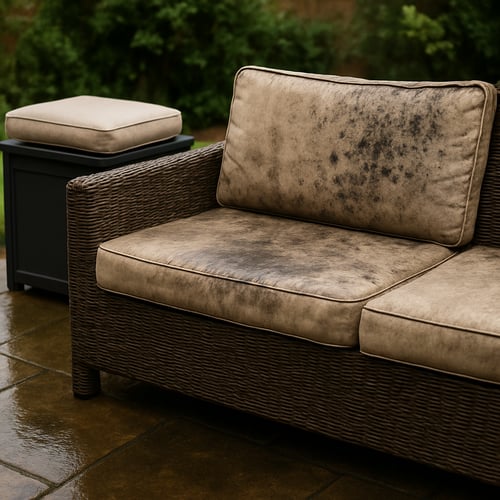Outdoor furniture cushions enhance comfort and style, but need proper protection to stay looking good. Learning how to store outdoor cushions correctly prevents costly replacements while keeping your outdoor space fresh. Smart storage solutions protect against weather damage, mold, and fading while complementing your garden design.
Why proper cushion storage matters
Patio cushions face constant exposure to elements that gradually damage fabric, filling, and structure. Proper storage extends cushion life while maintaining comfort and appearance through multiple seasons. Without protection, even high-quality cushions suffer permanent damage within months of outdoor exposure.
Quality storage solutions cost far less than frequent replacements. Weather-resistant fabrics still need protection from moisture, UV rays, and temperature changes. Regular storage routines preserve both function and looks of your outdoor investments.
Weather damage, mould, and fading – what to avoid
Moisture is the biggest threat to outdoor furniture cushions, causing mould growth, fabric damage, and bad smells. Even water-resistant fabrics break down after prolonged wet conditions, especially in warm temperatures. Mould spores get deep into filling, making removal nearly impossible.
UV radiation breaks down fabric fibres and causes colour fading in direct sunlight. Bright colours fade within single seasons without protection. Temperature changes stress materials through expansion and contraction, reducing lifespan dramatically.
When should you store outdoor cushions? (daily vs seasonal)
Daily storage depends on local weather and cushion quality. Large outdoor cushions with water-resistant covers may stay out during good weather, but require protection when rain threatens. Lightweight cushions benefit from daily storage to prevent wind damage.
Seasonal storage is essential for all cushions during winter months. Garden furniture cushions should move to protected areas before first frost. Spring prep involves cleaning and inspection before returning to outdoor use.
Best storage solutions for outdoor cushions
Waterproof storage boxes provide complete protection with easy access for regular use. Choose boxes with ventilation to prevent moisture buildup while keeping water out. Size should fit your largest cushions without damaging compression.
Cushions for outdoor furniture need different storage based on size and use frequency. Stackable systems work well for multiple sets, while individual covers suit occasional items. Quality solutions feature UV-resistant materials and secure closures.
Indoor storage offers maximum protection but requires space in homes or sheds. Garages, basements, and spare rooms provide ideal conditions when properly ventilated. Clean cushions thoroughly before indoor storage to prevent pests and odours.
Consider these storage options:
- Deck boxes with waterproof seals and ventilation
- Furniture covers designed for cushion protection
- Indoor rooms with controlled temperature
- Hanging systems that use vertical space
Cushion storage for small gardens and balconies
Limited spaces require creative solutions that maximize protection while saving room. Vertical storage uses wall space without taking floor area. Under-seat boxes provide seating while protecting cushions beneath.
Multi-functional furniture integrates storage into small outdoor spaces. Storage ottomans hold several small cushions while providing extra seating. Benches with lift-up seats create hidden compartments perfect for compact areas.
Wall-mounted cabinets keep cushions protected while staying accessible. Weather-resistant materials blend with existing décor. Proper installation ensures stability and security for cushion investments.
Storage that blends with your garden design
Modern design incorporates storage as intentional features rather than necessities. Contemporary boxes complement furniture styles while providing protection. Materials like teak, wicker, and metal blend with existing garden furniture collections.
Colour coordination creates cohesive themes throughout garden spaces. Neutral tones work with changing decorations, while bold colours make attractive focal points. Quality finishes resist fading to maintain appearance over seasons.
Built-in solutions integrate permanently into designs for visual harmony. Custom benches with storage provide seating while hiding cushions. Natural materials like cedar develop attractive patinas while providing reliable protection.
Decorative storage options include:
- Wicker chests matching existing furniture
- Wooden boxes with attractive hardware
- Contemporary metal with clean lines
- Built-in solutions maximizing space
How to store outdoor cushions when it rains
Quick action prevents water damage when rain threatens. Storage solutions should be easily accessible without extensive preparation. Waterproof covers provide temporary protection when permanent storage isn't possible.
Efficient systems minimize handling time while ensuring complete moisture protection. Pre-positioned containers allow rapid collection during weather changes. Practice routines during calm weather for smooth execution when time is critical.
Rain storage approaches:
- Easy-access boxes near seating areas
- Lightweight covers for brief showers
- Covered areas like gazebos with waterproof roofing
- Indoor routines for extended rainy periods
How to store outdoor cushions for winter
Winter storage requires comprehensive preparation including deep cleaning, complete drying, and secure containers. Storage locations should maintain stable above-freezing temperatures while preventing moisture. Spring prep involves inspection and re-treatment before outdoor use returns.
Regular inspection prevents minor problems becoming major issues during storage. Check monthly for moisture, pests, or other developing issues. Address issues immediately to prevent widespread damage.
Proper ventilation stays critical throughout storage to prevent condensation and mould. Ensure containers maintain airflow while excluding moisture and pests. Adjust ventilation based on seasonal humidity and temperature changes.
Smart storage solutions for every outdoor space
Successful storage combines practical protection with good looks while fitting space limits and usage patterns. Quality investments pay through extended cushion life and maintained comfort. Regular maintenance ensures continued effectiveness and attractive integration with garden designs through multiple seasons.
Explore more topics:
Author: Dako Furniture Team



